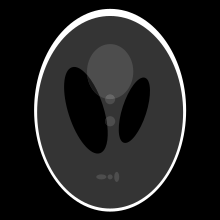|
 Image of the Shepp–Logan Phantom Image of the Shepp–Logan Phantom
The Shepp–Logan phantom is a standard test image created by Larry Shepp and Benjamin F. Logan for their 1974 paper "The Fourier Reconstruction of a Head Section".[1] It serves as the model of a human head in the development and testing of image reconstruction algorithms.[2][3][4]
Definition
The function describing the phantom is defined[1] as the sum of 10 ellipses inside a 2×2 square:
| Ellipse |
Center |
Major Axis |
Minor Axis |
Theta |
Gray Level
|
| a |
(0,0) |
0.69 |
0.92 |
0 |
2
|
| b |
(0,−0.0184) |
0.6624 |
0.874 |
0 |
−0.98
|
| c |
(0.22,0) |
0.11 |
0.31 |
−18° |
−0.02
|
| d |
(−0.22,0) |
0.16 |
0.41 |
18° |
−0.02
|
| e |
(0,0.35) |
0.21 |
0.25 |
0 |
0.01
|
| f |
(0,0.1) |
0.046 |
0.046 |
0 |
0.01
|
| g |
(0,−0.1) |
0.046 |
0.046 |
0 |
0.01
|
| h |
(−0.08,−0.605) |
0.046 |
0.023 |
0 |
0.01
|
| i |
(0,−0.605) |
0.023 |
0.023 |
0 |
0.01
|
| j |
(0.06,−0.605) |
0.023 |
0.046 |
0 |
0.01
|
References
See also
Standard test items |
|---|
| | Artificial intelligence | |
|---|
| Television (test card) |
- SMPTE color bars
- EBU colour bars
- Indian-head test pattern
- EIA 1956 resolution chart
- BBC Test Card A, B, C, D, E, F, G, H, J, W, X
- ETP-1
- Philips circle pattern (PM 5538, PM 5540, PM 5544, PM 5644)
- Snell & Wilcox SW2/SW4
- Telefunken FuBK
- TVE test card
- UEIT
|
|---|
| Computer languages | |
|---|
| Data compression | |
|---|
| 3D computer graphics | |
|---|
| Machine learning | |
|---|
| Typography (filler text) | |
|---|
| Other | |
|---|
|
